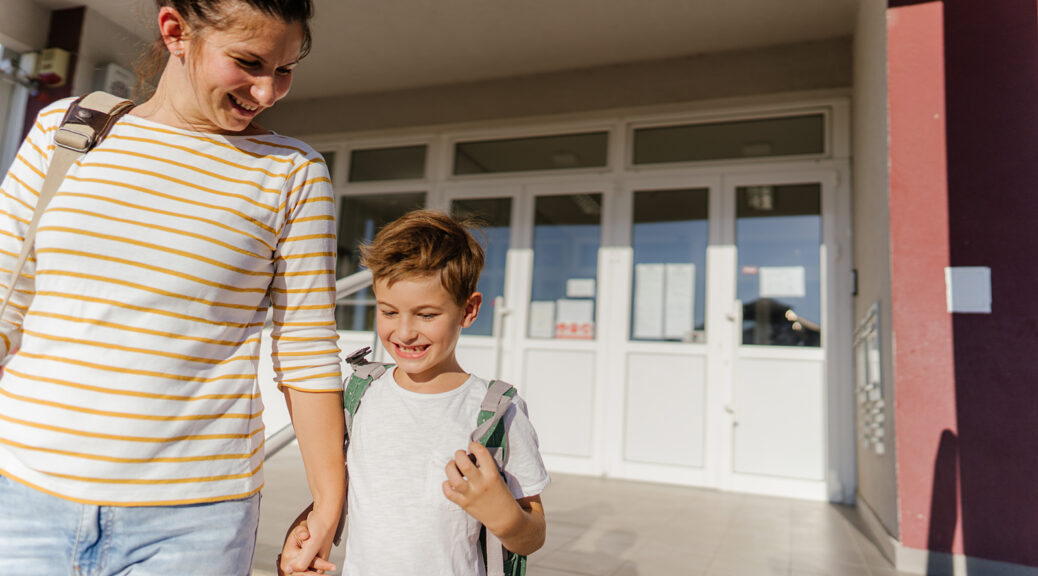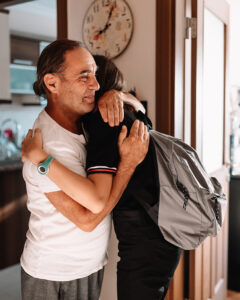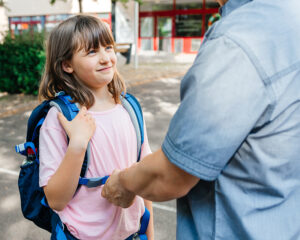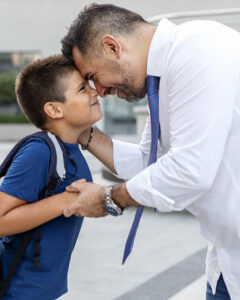Back to School Anxiety: How Parents Can Help Set Their Children Up for Success

The back-to-school season can drum up all sorts of feelings and emotions, from worry to acceptance and anxiousness to excitement! Anxiety can be a significant struggle for children going back to school, and many parents wonder how to help them understand their feelings. How can caregivers navigate this new season and set their children up for success? Let’s explore some expert strategies to help children cope.
Is your child struggling with anxiety? KVC can help. Learn more about our child and family mental health therapy services.
Different Kinds of Anxiety Children Experience Leading Into the Back-to-School Season
 Children can experience various types of anxiety leading into school. Some of us consider anxiety to be a bad thing, but it’s a normal and natural emotion, explains Michelle Cooper, KVC West Virginia Regional Director. “Anxiety is a natural emotion that we all experience,” she says. “Anxiety helps us with lots of things, like protecting us from dangerous situations. But when children and teens experience heightened anxiety, it can become a problem.”
Children can experience various types of anxiety leading into school. Some of us consider anxiety to be a bad thing, but it’s a normal and natural emotion, explains Michelle Cooper, KVC West Virginia Regional Director. “Anxiety is a natural emotion that we all experience,” she says. “Anxiety helps us with lots of things, like protecting us from dangerous situations. But when children and teens experience heightened anxiety, it can become a problem.”
It’s crucial for parents, teachers and caregivers to create a nurturing environment and support children in managing their anxiety and adjusting to the school setting. Parents and caregivers can try to narrow down which anxieties are causing the most concern for their children.
Back-to-school anxiety can manifest as:
- Separation anxiety: Young children may feel anxious about being separated from their parents or caregivers. Superstation anxiety may increase in a new environment.
- Social anxiety: Some children may feel anxious about making new friends or interacting with their peers. They may worry about being accepted or fitting in.
- Performance anxiety: Children may feel pressure to perform well academically or in extracurricular activities. They might be afraid they can’t keep up with a busy schedule or high expectations.
 Bullying anxiety: Children who have experienced bullying in the past may feel anxious about going to school and being around the bully or their peers. And today’s children and teens can feel anxious about not just face-to-face bullying at school, but cyberbullying too. “When bullying is happening digitally, it’s easier for caregivers and teachers to miss the signs,” Cooper explains.
Bullying anxiety: Children who have experienced bullying in the past may feel anxious about going to school and being around the bully or their peers. And today’s children and teens can feel anxious about not just face-to-face bullying at school, but cyberbullying too. “When bullying is happening digitally, it’s easier for caregivers and teachers to miss the signs,” Cooper explains.- Generalized anxiety: Some children may experience generalized anxiety, which can manifest as excessive worry or fear about various aspects of school. This could include fears around academic performance, social interactions or safety.
- Transition anxiety: Moving from one grade level to another or transitioning to a new school can cause anxiety. They may worry about unfamiliar routines, expectations or new teachers.
- Post-pandemic anxiety: For many, the shift in spring 2020 from school-as-usual to online and remote learning was abrupt and anxiety-inducing. Some students may feel residual anxiety from this difficult season. “Especially for younger children whose brains are still developing, they missed out on a lot of socialization and engagement during that time, which can be a key driver of anxiety,” Cooper says.
“Be sure to give them praise and validate their efforts in facing their fears! Let them know that you’ve seen how strong they can be.”
Understanding the Difference Between Typical Back-to-School Jitters and Heightened Anxiety
Sometimes it can be tough for parents, caregivers and school staff to notice if a child is facing common back-to-school jitters or something more intense. Here’s how you can tell the difference between a little unease and a significant anxiety struggle:
 Level of Intensity
Level of Intensity
Back-to-school jitters typically look like mild nervousness or excitement that is temporary. It usually subsides once the child settles into the school routine. While heightened anxiety in children is characterized by more intense and persistent feelings of worry, fear or unease that can significantly impact their daily functioning.
Length of Time
Back-to-school jitters are usually short-lived and tend to diminish as children become more familiar with their new school environment and routine. Heightened anxiety, however, can persist for an extended period. This can cause ongoing distress and interfere with the child’s ability to engage in school activities.
Avoidance Tendencies
Typical anxiety can manifest as reluctance, but heightened anxiety can look like avoidance. “Children may refuse to go to school and complain their tummy hurts or head hurts, or older kids may skip school altogether,” Cooper explains. “But when we avoid things that make us anxious, that can often reinforce the anxiety.”
Impact on Daily Life

Back-to-school jitters might cause some temporary disruptions or difficulties in a child’s daily routine. This may include trouble sleeping or mild stomach aches. However, heightened anxiety can have a more significant impact on a child’s daily life. If left unaddressed it can lead to difficulties concentrating, avoiding school or social situations, physical symptoms (like headaches or nausea) or even panic attacks.
Triggers
Back-to-school jitters are often triggered by the anticipation of returning to school after a break or transitioning to a new grade level. Heightened anxiety, on the other hand, may be triggered by specific situations or events. Exams, social interactions or previous negative experiences at school might be the source of anxiety.
It’s essential for caregivers to monitor and differentiate between back-to-school jitters and heightened anxiety in children. This allows adults to provide appropriate support or find additional help when necessary. “If anxiety does seem to be getting more severe, it’s important to intervene quickly,” Cooper says.
If a child’s anxiety continues, gets worse, or significantly impacts their daily life, it may be beneficial to consider guidance from a mental health professional. KVC provides an array of helpful resources, treatments, and therapies to children and families who are looking for extra support in their child’s overall wellbeing.
“If anxiety does seem to be getting more severe, it’s important to intervene quickly.”
How Can Caregivers Help Their Children Handle Anxiety in a Healthy Way?
As caregivers, it’s essential to recognize and address the emotions of our children, especially stress and anxiety, to help them navigate the back-to-school transition healthily and positively. “Preparation is a key way to prevent anxiety,” Cooper says. Being proactive, communicating thoroughly and affirming their courage can be helpful for young people of all ages. How can you help a child or teen in your care?
 Pre-Kindergarten & Kindergarten
Pre-Kindergarten & Kindergarten
The transition into pre-kindergarten or straight into kindergarten, especially after staying at home with family or with a babysitter, is among one of the first major steps in a child’s life. Caregivers may worry if their child is ready for such an important step. Luckily, children are resilient, and with some preparation and encouragement, they’ll feel more confident about their transition into the school year.
With that said, here are some helpful suggestions to help your Pre-K or Kindergartener with their back-to-school anxieties:
- Visit the School and Meet the Teacher: If possible, make this a priority. Getting to see their school and meeting the teacher builds familiarity, helping calm nerves about being in a new place.
- Adjust Routines: A few weeks before school begins, start practicing a routine that will work during school. This usually includes earlier bedtimes and allowing enough time in the morning to get ready without feeling rushed.
- Note the Necessary Information: Labels and notes are helpful for children and adults. Add labels to school items and create an informational note about allergies, special needs or other important information.
- Foster Independence: Practice putting on and taking off shoes and jackets, and going to the restroom without as much help. It’ll help your children gain courage and confidence.
- Communicate Openly: Talk with your child, ask questions and create a safe place for your child to express where they might have concerns or anxieties. And if you’re feeling a little uncertain too, it’s okay to share that as a way to illustrate that anxiety is normal! Another great way to spark conversation is to read books about going to school like Pete the Cat: Rocking My School Shoes and Mom, It’s My First Day of Kindergarten.
- Stay Positive and Encouraging: Focus on the best parts of school, and be sure to give extra encouragement on the first day, leaving your child with a smile instead of tears.
“Preparation is a key way to prevent anxiety.”
Elementary School
Elementary-aged children will likely continue benefiting from the suggestions listed for Pre-kindergarten and Kindergarten. However, there are a few additional options for older children to help them regulate and cope with anxiety. Caregivers can:
- Create a Toolbox for Anxiety: Aid your child in creating a mental health toolkit to use during times of high stress or anxiety. This helps children practice coping with feelings of anxiety and can benefit them for years to come.
 Practice Relaxation Techniques: Teach your child relaxation techniques, such as deep breathing exercises, grounding or mindfulness, to help them manage their anxiety. Encourage them to practice these techniques whenever they feel overwhelmed or stressed.
Practice Relaxation Techniques: Teach your child relaxation techniques, such as deep breathing exercises, grounding or mindfulness, to help them manage their anxiety. Encourage them to practice these techniques whenever they feel overwhelmed or stressed.- Encourage Positive Self-Talk: Help your child develop positive self-talk by teaching them to challenge negative thoughts and replace them with positive, realistic ones. Encourage them to focus on their strengths and remind them of past successes in similar situations.
- Foster Social Connections: Encourage your child to maintain and develop social connections with peers. Arrange playdates or social activities with their friends to help reduce feelings of isolation and build a support network.
- Collaborate with School Staff: Maintain open communication with your child’s teachers and school staff. Share your child’s anxiety concerns, so they can provide additional support and understanding. Collaborate on strategies to help your child transition smoothly into the school environment.
Middle School and High School
 As children get older, caregivers might have a better understanding of how they can support their children in coping with back-to-school anxiety in healthy ways. However, since they are still developing, it’s important to use the following strategies:
As children get older, caregivers might have a better understanding of how they can support their children in coping with back-to-school anxiety in healthy ways. However, since they are still developing, it’s important to use the following strategies:
- Be a Role Model: One of the best ways to help children of all ages is to model healthy coping strategies. Children often mirror their caregivers’ behavior, so demonstrating healthy ways to handle stress can positively influence their own coping skills.
- Promote Healthy Technology Use: Pre-teens and teens, compared to younger children, are more likely to feel anxiety and pressure due to technology, especially social media and cyberbullying. Help them cope with anxiety by promoting smart tech habits, especially setting boundaries and setting aside time to be screen-free.
- Encourage Self-Care: Teach your child the importance of self-care and encourage activities that promote their wellbeing. This can include hobbies, exercise, reading or spending time with family and friends.
By teaching children coping skills early, caregivers are setting them up for lifelong success. And when they do overcome their anxiety, Cooper says, don’t forget to cheer them on! “Be sure to give them praise and validate their efforts in facing their fears! Let them know that you’ve seen how strong they can be.”
